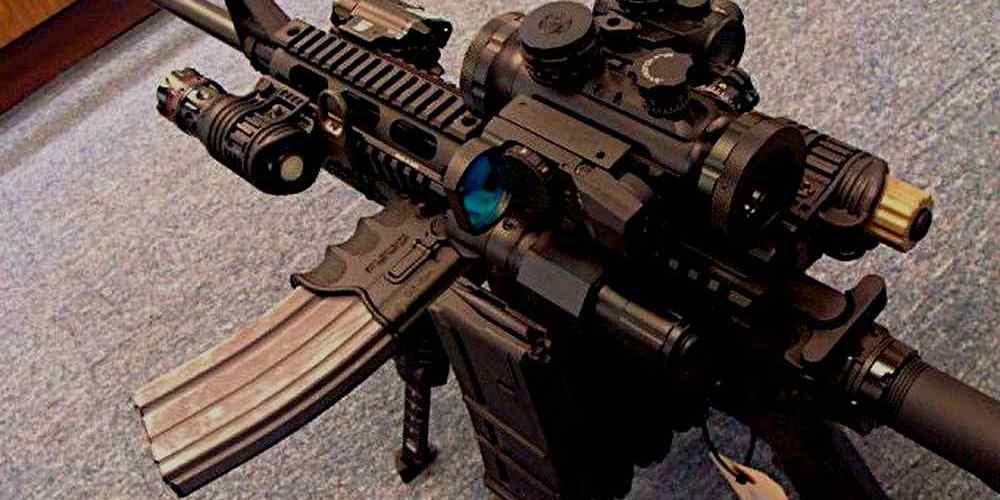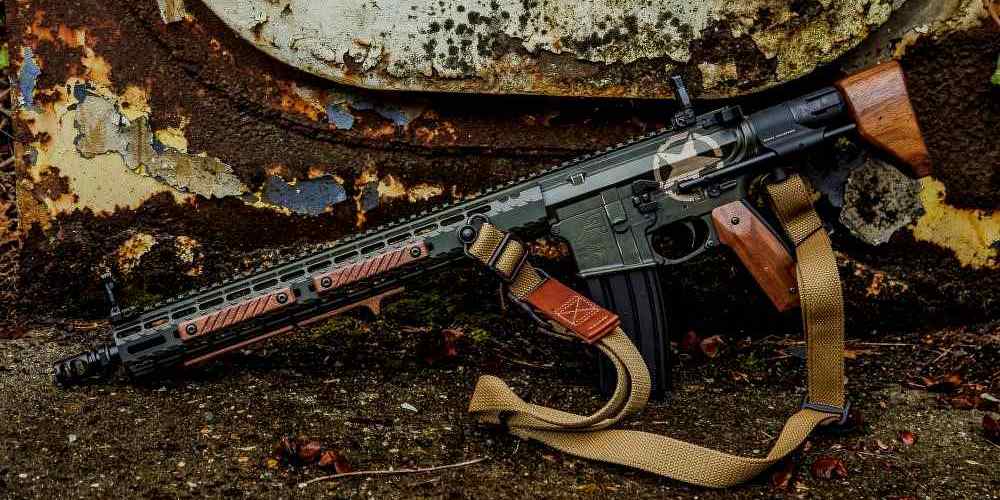“Built to withstand the toughest conditions, your ultimate guide to crafting a rugged AR15 for extreme use.”
Selecting the Best Materials for Extreme Durability
When it comes to building an AR15 for extreme conditions, durability is key. Whether you’re a seasoned shooter or a novice looking to build your first rifle, selecting the best materials is crucial to ensure your rifle can withstand the harshest environments and abuse. In this guide, we’ll walk you through the process of choosing the right materials for your hard-use AR15 build.
One of the most important components of an AR15 is the receiver. When it comes to extreme durability, forged aluminum is the way to go. Forged receivers are stronger and more durable than their cast counterparts, making them ideal for hard-use rifles. Look for receivers that are made from 7075-T6 aluminum, as this material offers the highest strength and durability.
In addition to the receiver, the barrel is another critical component of an AR15 build. When selecting a barrel for extreme conditions, look for one that is made from high-quality stainless steel. Stainless steel barrels are more resistant to corrosion and wear, making them ideal for harsh environments. Additionally, consider a barrel with a chrome-lined bore and chamber for added durability and ease of cleaning.
When it comes to the bolt carrier group (BCG), opt for one that is made from high-quality materials such as Carpenter 158 steel or 9310 steel. These materials are known for their strength and durability, making them ideal for hard-use rifles. Additionally, consider a BCG with a nickel boron or nitride coating for added lubricity and corrosion resistance.
Another important consideration when building an AR15 for extreme conditions is the handguard. Look for a handguard that is made from lightweight yet durable materials such as aluminum or carbon fiber. Additionally, consider a free-floating handguard for improved accuracy and heat dissipation.
When it comes to the stock and grip, choose materials that are both durable and comfortable. Look for a stock and grip that are made from high-quality polymer or aluminum for maximum durability. Additionally, consider a stock with a rubberized or textured surface for improved grip in wet or muddy conditions.
In addition to selecting the right materials, proper maintenance and care are essential for keeping your hard-use AR15 in top condition. Regular cleaning and lubrication are key to preventing corrosion and wear, especially in extreme environments. Additionally, consider investing in a high-quality case or bag to protect your rifle during transport and storage.
In conclusion, building an AR15 for extreme conditions requires careful consideration of the materials used in the build. By selecting high-quality materials such as forged aluminum, stainless steel, and high-strength steel, you can ensure that your rifle is up to the task of withstanding the harshest environments and abuse. With proper maintenance and care, your hard-use AR15 will serve you well for years to come.

Customizing Your AR15 for Harsh Environments
Building an AR15 for extreme conditions requires careful consideration of the components and modifications that will ensure the rifle can withstand harsh environments. Whether you are a seasoned shooter or a novice looking to customize your AR15, there are several key factors to keep in mind when building a hard-use rifle.
One of the first things to consider when customizing your AR15 for extreme conditions is the choice of materials. Opting for high-quality, durable materials such as stainless steel or nitrided steel can help increase the rifle’s longevity and resistance to corrosion. Additionally, choosing components that are designed specifically for hard-use applications, such as heavy-duty bolt carriers and reinforced buffer tubes, can further enhance the rifle’s durability.
Another important consideration when building an AR15 for extreme conditions is the selection of a reliable and robust barrel. A high-quality barrel with a durable finish, such as chrome lining or nitride coating, can help protect the barrel from wear and tear caused by harsh environments. Additionally, choosing a barrel with a heavy profile can help improve the rifle’s accuracy and stability, especially when shooting in adverse conditions.
In addition to selecting the right materials and components, customizing your AR15 for extreme conditions also involves making strategic modifications to enhance the rifle’s performance. One popular modification for hard-use rifles is the addition of a free-floating handguard, which can help improve accuracy by reducing barrel harmonics and minimizing interference from external factors.
Another modification to consider when building an AR15 for extreme conditions is the installation of a high-quality trigger system. Upgrading to a precision trigger can help improve the rifle’s accuracy and consistency, especially when shooting in challenging conditions. Additionally, choosing a trigger with a crisp break and short reset can help enhance the shooter’s overall experience and performance.
When customizing your AR15 for extreme conditions, it is also important to consider the rifle’s overall ergonomics and handling. Adding features such as an adjustable stock, ambidextrous controls, and enhanced grip options can help improve the rifle’s comfort and usability, especially when shooting for extended periods or in adverse conditions.
Finally, when building an AR15 for extreme conditions, it is essential to test the rifle in various environments and conditions to ensure its reliability and performance. Conducting regular maintenance and inspections, as well as keeping the rifle clean and properly lubricated, can help prevent malfunctions and ensure the rifle is ready for use in any situation.
In conclusion, customizing your AR15 for extreme conditions requires careful consideration of materials, components, and modifications that will enhance the rifle’s durability, reliability, and performance. By selecting high-quality materials, making strategic modifications, and testing the rifle in various conditions, you can build a hard-use rifle that is ready to withstand the toughest challenges. Whether you are a seasoned shooter or a novice looking to customize your AR15, following these guidelines can help you build a rifle that is capable of performing in even the most extreme environments.
Upgrading Components for Increased Reliability
When it comes to building an AR15 for extreme conditions, one of the most important factors to consider is the reliability of the rifle. In harsh environments, such as desert heat, arctic cold, or wet and muddy conditions, your rifle needs to be able to perform flawlessly. This is where upgrading components for increased reliability comes into play.
One of the first components to consider upgrading is the bolt carrier group (BCG). The BCG is the heart of the AR15, responsible for cycling the action and chambering rounds. For extreme conditions, a high-quality BCG made from materials like Carpenter 158 steel or 9310 steel is essential. These materials are known for their durability and resistance to wear and tear. Additionally, a properly staked gas key and a chrome-lined interior will help prevent gas leaks and ensure smooth operation in adverse conditions.
Another crucial component to upgrade is the barrel. A high-quality barrel made from materials like chrome-moly steel or stainless steel will provide increased accuracy and longevity. Additionally, a chrome-lined or nitride-coated barrel will offer increased resistance to corrosion and fouling, making it ideal for harsh environments. Consider a heavy-profile barrel for increased heat dissipation and reduced barrel whip, which can improve accuracy and reliability.
Next, consider upgrading the trigger group. A crisp and consistent trigger pull is essential for accuracy and control, especially in high-stress situations. A quality drop-in trigger kit with a reduced pull weight and minimal creep will help you make precise shots under extreme conditions. Look for a trigger with a durable coating or finish to prevent corrosion and ensure long-term reliability.
Another component to consider upgrading is the buffer system. A heavy buffer and buffer spring can help reduce felt recoil and improve the rifle’s overall reliability. Additionally, a buffer system designed for suppressed use can help mitigate the increased gas pressure and fouling that can occur when shooting with a suppressor. Consider upgrading to a high-quality buffer tube made from materials like 7075-T6 aluminum for increased strength and durability.
Finally, consider upgrading the handguard and stock of your AR15 for increased reliability in extreme conditions. A free-floating handguard made from materials like aluminum or carbon fiber will provide increased accuracy and heat dissipation. Look for a handguard with M-LOK or KeyMod attachment points for mounting accessories like lights, lasers, and grips. Additionally, consider upgrading to a collapsible or fixed stock made from materials like polymer or aluminum for increased durability and comfort.
In conclusion, upgrading components for increased reliability is essential when building an AR15 for extreme conditions. By investing in high-quality components like a durable BCG, barrel, trigger group, buffer system, handguard, and stock, you can ensure that your rifle will perform flawlessly in harsh environments. Remember to regularly maintain and clean your rifle to prevent malfunctions and ensure long-term reliability. With the right upgrades and proper care, your AR15 will be ready to handle whatever extreme conditions you may encounter.
Maintenance Tips for AR15s in Extreme Conditions
Building an AR15 for extreme conditions requires careful consideration of the components and materials used in the rifle. Whether you are a seasoned shooter or a novice gun enthusiast, having a reliable and durable rifle is essential for any shooting situation. In this guide, we will discuss some maintenance tips for AR15s in extreme conditions to ensure your rifle performs at its best when you need it most.
One of the most important aspects of maintaining an AR15 in extreme conditions is regular cleaning and lubrication. Dirt, dust, and debris can quickly build up in the rifle’s action, causing malfunctions and reducing accuracy. To prevent this, it is essential to clean your rifle after each use, especially if you have been shooting in harsh environments such as sandy deserts or muddy fields.
When cleaning your AR15, be sure to disassemble the rifle completely to access all the internal components. Use a high-quality gun cleaning solvent to remove any fouling and carbon buildup from the barrel, bolt carrier group, and other critical parts. After cleaning, apply a thin layer of gun oil or lubricant to all moving parts to ensure smooth operation and prevent corrosion.
In addition to regular cleaning, it is also important to inspect your AR15 for any signs of wear or damage. Check the barrel for signs of erosion or pitting, as this can affect accuracy and barrel life. Inspect the gas system for any leaks or blockages, and ensure that all pins, springs, and screws are tight and secure.
Another important maintenance tip for AR15s in extreme conditions is to use high-quality, durable components. When building your rifle, opt for parts made from materials such as stainless steel, aluminum, or titanium, which are known for their strength and corrosion resistance. Investing in quality components may cost more upfront, but it will pay off in the long run by ensuring your rifle can withstand harsh conditions without failing.
When selecting accessories for your AR15, choose items that are designed for hard use. Opt for rugged optics, such as red dot sights or holographic sights, that can withstand recoil and impact. Consider adding a durable handguard or foregrip to protect your rifle’s barrel and provide a comfortable grip in adverse conditions.
Lastly, it is essential to practice proper storage and transportation of your AR15 to protect it from extreme conditions. Store your rifle in a secure, climate-controlled environment to prevent rust and corrosion. When transporting your rifle, use a high-quality case or bag to shield it from dust, moisture, and impact.
In conclusion, maintaining an AR15 for extreme conditions requires attention to detail and a commitment to quality. By following these maintenance tips, you can ensure that your rifle performs reliably in any shooting situation. Remember to clean and lubricate your rifle regularly, inspect it for wear and damage, use high-quality components, and store it properly to protect it from harsh environments. With proper care and maintenance, your AR15 will be ready for whatever challenges come your way.
Testing Your Hard-Use AR15 in Challenging Scenarios
Building an AR15 for extreme conditions requires careful consideration of various factors to ensure that your rifle can withstand the harshest environments and still perform reliably. Once you have assembled your hard-use AR15, it is essential to test it in challenging scenarios to ensure that it meets your expectations and performs as intended.
One of the first things you should do when testing your hard-use AR15 is to check the functionality of all components. This includes testing the trigger, safety selector, magazine release, and bolt catch to ensure that they operate smoothly and without any issues. It is also important to check the fit and finish of all parts to ensure that they are properly installed and secured.
Once you have verified the functionality of all components, it is time to test your hard-use AR15 in various shooting scenarios. This can include shooting in extreme temperatures, high humidity, and dusty environments to simulate real-world conditions. It is important to test your rifle in these conditions to ensure that it can withstand the elements and still perform reliably.
Another important aspect of testing your hard-use AR15 is to test its accuracy and reliability. This can be done by shooting at different distances and using various types of ammunition to see how your rifle performs. It is also important to test the rifle’s reliability by shooting it in rapid succession to see if it can handle the stress of continuous firing.
In addition to testing your hard-use AR15 in challenging shooting scenarios, it is also important to test its durability and resistance to wear and tear. This can be done by subjecting your rifle to rough handling, dropping it on hard surfaces, and exposing it to harsh chemicals to see how it holds up. It is important to test your rifle in these conditions to ensure that it can withstand the rigors of hard use.
When testing your hard-use AR15, it is important to keep detailed records of your testing procedures and results. This can help you identify any issues or areas for improvement and make necessary adjustments to ensure that your rifle performs optimally in extreme conditions. It is also important to regularly maintain and clean your rifle to ensure that it continues to perform reliably over time.
In conclusion, testing your hard-use AR15 in challenging scenarios is essential to ensure that it can withstand the harshest environments and still perform reliably. By checking the functionality of all components, testing your rifle in various shooting scenarios, and evaluating its accuracy, reliability, durability, and resistance to wear and tear, you can ensure that your hard-use AR15 is ready for any situation. Remember to keep detailed records of your testing procedures and results and regularly maintain and clean your rifle to ensure that it continues to perform optimally in extreme conditions.



